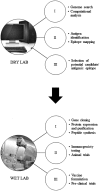Current progress of immunoinformatics approach harnessed for cellular- and antibody-dependent vaccine design
- PMID: 29528265
- PMCID: PMC6056828
- DOI: 10.1080/20477724.2018.1446773
Current progress of immunoinformatics approach harnessed for cellular- and antibody-dependent vaccine design
Erratum in
-
Corrigendum.Pathog Glob Health. 2020 Mar;114(2):II. doi: 10.1080/20477724.2018.1459242. Epub 2018 Apr 27. Pathog Glob Health. 2020. PMID: 29701139 Free PMC article. No abstract available.
Abstract
Immunoinformatics plays a pivotal role in vaccine design, immunodiagnostic development, and antibody production. In the past, antibody design and vaccine development depended exclusively on immunological experiments which are relatively expensive and time-consuming. However, recent advances in the field of immunological bioinformatics have provided feasible tools which can be used to lessen the time and cost required for vaccine and antibody development. This approach allows the selection of immunogenic regions from the pathogen genomes. The ideal regions could be developed as potential vaccine candidates to trigger protective immune responses in the hosts. At present, epitope-based vaccines are attractive concepts which have been successfully trailed to develop vaccines which target rapidly mutating pathogens. In this article, we provide an overview of the current progress of immunoinformatics and their applications in the vaccine design, immune system modeling and therapeutics.
Keywords: Antigen; bioinformatics; epitope prediction; human leukocyte antigen (HLA); immunoinformatics; in silico tools; major histocompability (MHC); reverse vaccinology; vaccine design.
Figures
Similar articles
-
Immunoinformatic Identification of Potential Epitopes.Methods Mol Biol. 2020;2131:265-275. doi: 10.1007/978-1-0716-0389-5_14. Methods Mol Biol. 2020. PMID: 32162260
-
Immunoinformatics: In Silico Approaches and Computational Design of a Multi-epitope, Immunogenic Protein.Int Rev Immunol. 2019;38(6):307-322. doi: 10.1080/08830185.2019.1657426. Epub 2019 Sep 3. Int Rev Immunol. 2019. PMID: 31478759
-
Computational tools for epitope vaccine design and evaluation.Curr Opin Virol. 2015 Apr;11:103-12. doi: 10.1016/j.coviro.2015.03.013. Epub 2015 Mar 31. Curr Opin Virol. 2015. PMID: 25837467 Free PMC article. Review.
-
Computational vaccinology and epitope vaccine design by immunoinformatics.Acta Microbiol Immunol Hung. 2014 Sep;61(3):285-307. doi: 10.1556/AMicr.61.2014.3.4. Acta Microbiol Immunol Hung. 2014. PMID: 25261943
-
Better Epitope Discovery, Precision Immune Engineering, and Accelerated Vaccine Design Using Immunoinformatics Tools.Front Immunol. 2020 Apr 7;11:442. doi: 10.3389/fimmu.2020.00442. eCollection 2020. Front Immunol. 2020. PMID: 32318055 Free PMC article. Review.
Cited by
-
Immunoinformatics and molecular dynamics approaches: Next generation vaccine design against West Nile virus.PLoS One. 2021 Jun 17;16(6):e0253393. doi: 10.1371/journal.pone.0253393. eCollection 2021. PLoS One. 2021. PMID: 34138958 Free PMC article.
-
Just Keep Rolling?-An Encompassing Review towards Accelerated Vaccine Product Life Cycles.Vaccines (Basel). 2023 Jul 27;11(8):1287. doi: 10.3390/vaccines11081287. Vaccines (Basel). 2023. PMID: 37631855 Free PMC article. Review.
-
Epitope mapping of Acinetobacter baumannii outer membrane protein W (OmpW) and laboratory study of an OmpW-derivative peptide.Heliyon. 2023 Jul 25;9(8):e18614. doi: 10.1016/j.heliyon.2023.e18614. eCollection 2023 Aug. Heliyon. 2023. PMID: 37560650 Free PMC article.
-
A Novel Chimeric Antigen as a Vaccine Candidate against Leishmania major: In silico Analysis.Iran J Parasitol. 2021 Apr-Jun;16(2):186-198. doi: 10.18502/ijpa.v16i2.6267. Iran J Parasitol. 2021. PMID: 34557233 Free PMC article.
-
Engineering a multi-epitope chimera derived from Acinetobacter baumannii CAM87009.1 and FilF fimbriae proteins: immunogenic and antibiofilm activity.Braz J Microbiol. 2025 Jun;56(2):893-904. doi: 10.1007/s42770-025-01666-1. Epub 2025 Apr 24. Braz J Microbiol. 2025. PMID: 40274757
References
Publication types
MeSH terms
Substances
LinkOut - more resources
Full Text Sources
Other Literature Sources
Medical
Research Materials
Miscellaneous


